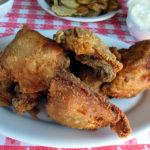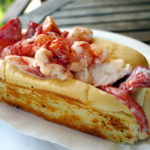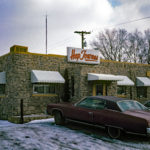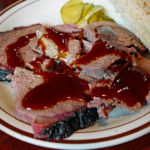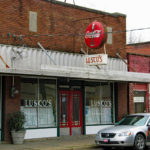Buffalo New York
Even if you have eaten the great roast beef sandwiches served at Al's #1 Italian Beef in Chicago, Mother's in New Orleans, and Philippe the Original in Los Angeles, you cannot say you have had the best roast beef sandwich in America until you have been to SCHWABL's in Buffalo, for the one known as beef on weck.
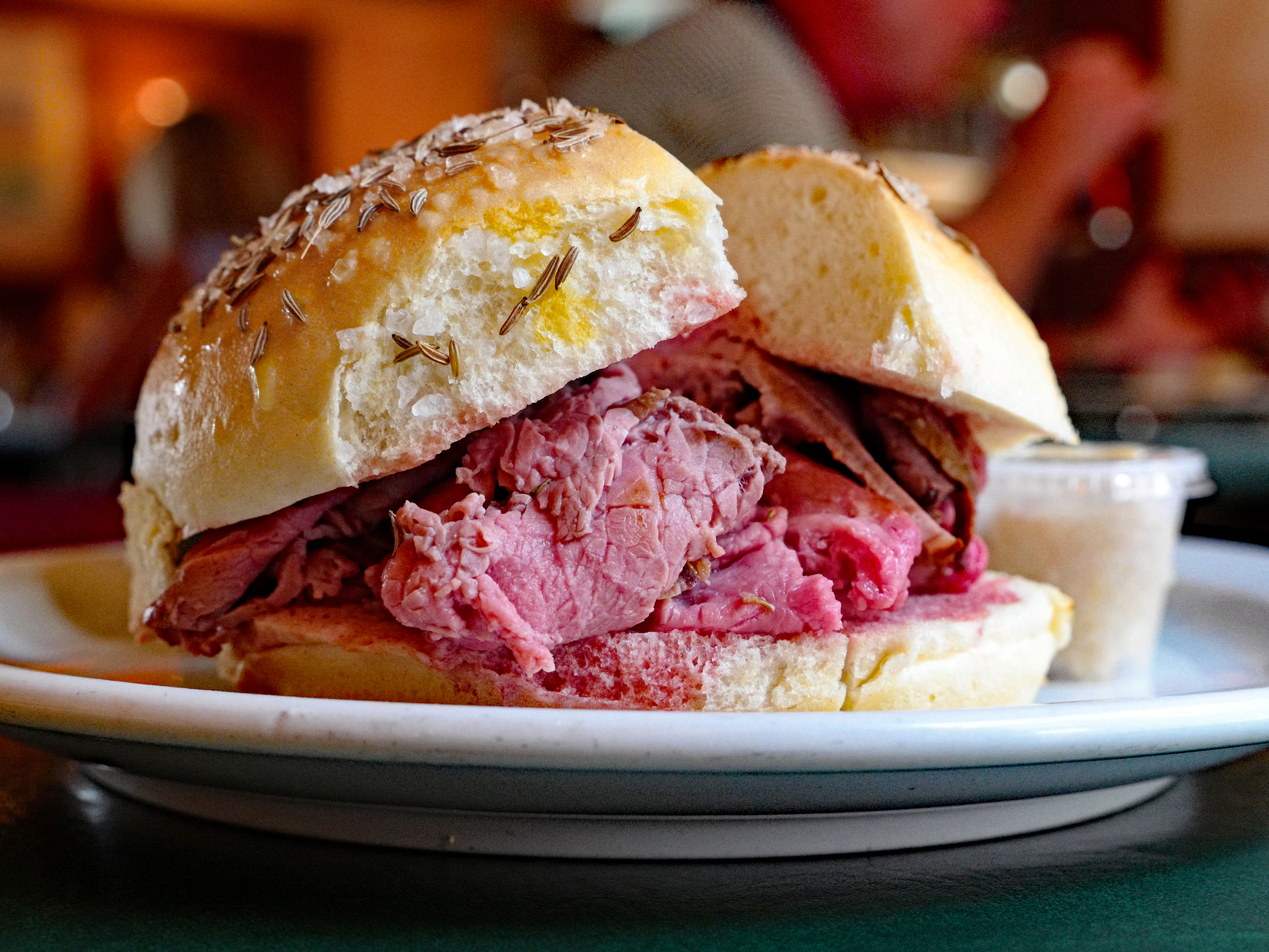
By Jane and Michael Stern
Originally Published 1999 Gourmet Magazine
Even if you have eaten the great roast beef sandwiches served at Al’s #1 Italian Beef in Chicago, Mother’s in New Orleans, and Philippe the Original in Los Angeles, you cannot say you have had the best roast beef sandwich in America until you have been to SCHWABL’s in Buffalo, for the one known as beef on weck.
The roast itself is a thing of beauty. A forty-pound center-cut round, draped with suet and seasoned with salt and pepper, is cooked to rare at a high temperature. The outside glistens with juice and turns dark; the inside stays vivid red. It is a serious hunk of food that jiggles when it’s moved around on the butcher block next to Schwabl’s bar in the dining room. As the carver plants a fork in the top and his knife glides easily into the center, slices settle onto the carving board like soft petals of a great crimson rose.
The warm meat is assembled in a mass about an inch tall on the bottom half of a unique sort of hard roll that is known in western New York State as a kummelweck.
From the German Kummel, meaning caraway seed, a kummelweck, or simply “weck,” is shaped like a kaiser roll but crowned with a mantle of seeds and coarse salt so abundant that it crunches audibly when bitten. It is tawny with an extraordinarily fine crumb. The roll’s light texture is crucial because it is designed to cushion but not compete with the gentle feel of the sliced beef. Its top half is customarily immersed in pan juices just long enough for it to start to soften before it is set atop the sandwich.
“When you cook a roast the way we do—fast, at a high temperature—it shrinks fifteen or twenty percent,” Ray Schwabl says as he leads us to twin ovens in the tiny kitchen at the back of his fifty-seat restaurant-and-tavern. “Equipment salesmen are always trying to sell me a modern roaster that would cook the meat with less shrinkage. But I tell them I don’t mind that shrinkage. I need that shrinkage! And this is why.” He opens the oven door, slides out a slow-sizzling roast pan, and lifts its lid. He uses a long spoon to stir the bottom of the pan, which is filling up with amber-hued juices drawn from the roast as it cooks. A concentrated beef aroma swirls up into the air. This protein perfume radiates throughout Schwabl’s restaurant all day long. “From these pure beef drippings I make gravy for the mashed potatoes or to ladle on french fries, and for the toast beef plates,” he says. “And to serve beef on weck right, you need the jus to moisten the rolls. This is a sandwich that no one orders dry.”
Ray Schwabl knows a thing or two about beef. His family started in the restaurant trade when his father’s great-grandfather, a brewmaster, came to Buffalo from Germany in 1837 and sold hot meals with beer from his house. The Schwabls have been serving Buffalonians good food ever since. A hundred years ago, the Genesee streetcar took weekend revelers directly to the door of the family’s immense public playground, known as Klein Deutschland, which featured rathskellers, bowling alleys, a shooting gallery, merry-go-rounds, and dance floors as well as dining rooms. Historians cannot confirm the precise origin of beef on weck, but the Schwabls like to think it was at one of their several restaurants in and around Buffalo that hot roast beef first was sandwiched inside kummelweck rolls, some time in the teens or twenties.
Now there is just one Schwabl’s in Buffalo, open since 1942. Beyond beef on week, the menu offers a delicious plate of hot ham with tomato sauce and such treats as liver dumpling soup (every Wednesday) and Hungarian goulash with dumplings (on Saturday night). Among the always-available sides are stout mashed potatoes drizzled with beef gravy and German potato salad rich with bacon flecks.
We recommend sitting toward the front of Schwabl’s, or at least waiting at the bar a spell (at peak mealtime, a wait should be expected), for here you have a view of the carving board and of Ray and his associates, Dave Brown and Claus Augenreich, making sandwiches. It is enthralling to watch them put their knives to the roast and neatly halve the kummel-weeks to be immersed in gravy, a process conducted with such earnestness and dignity that we are reminded of medical professionals at work—an impression abetted by the immaculate white smocks the trio wear, as well as by the extraordinarily sober tone of the dining room. Many dinner guests start their meal with expertly made Manhattans, Old Fashioneds, or Whiskey Sours, or, in winter, with Tom and Jerries—and cold beer flows as fast as beef is cut. But no one comes to Schwabl’s only to drink. “We Cater to Nice Homey Family Trade,” the menu announces; and a dry, nonalcoholic birch beer with the faint twang of spearmint is always available on draught.
It was beer that inspired the invention of beef on weck, according to Charlie Roesch, proprietor of CHARLIE THE BUTCHER’S KITCHEN. He believes it was back in the 1880s that a now-forgotten local tavern owner (perhaps a Schwabl) decided to offer a sandwich that would induce a powerful thirst in his patrons. The man had plenty of coarse salt on hand for the pretzels he served, so he painted a mixture of salt and caraway seeds atop some hard rolls, cooked a roast and sliced it thin, and piled the meat inside the rolls. As a condiment, he served hot horseradish. As diners slaked the thirst these sandwiches induced, beer sales soared. And Buffalo’s passion for beef on weck was born.
As Mr. Roesch stands at his butcher block rhapsodizing about his favorite subject—the cuisine of western New York—an attentive patron waiting at the order window of his restaurant offers support: “If Charlie the Butcher says it’s so, it’s so!” declares the customer before ordering a beef on week with a smoked Polish sausage on the side.
Charlie the Butcher’s fans consider him the ultimate authority on meat of all kinds. Although he is a young man who has operated this restaurant only since 1993 (a nanosecond compared to the 162-year Schwabl dynasty), he is hardly a Johnny-come-lately to the Buffalo beef scene. His father was a butcher, as was his grandfather, and he still manages a butcher shop and food kiosk at Buffalo’s century-old Broadway Market. To honor the family trade, he wears a white hard hat on his head and a butcher’s smock over his shirt and necktie as he works at counters in the center of his restaurant stirring soups, cutting cabbages for the Wednesday corned beef dinner, and—most important of all—slicing roasts for his own distinctive version of the city’s signature sandwich.
Charlie prepares his beef in a high-tech “cook-and-hold” oven that has an effect on meat similar to dry aging. Roasts are loaded in at 5 P.M. and ready to serve the next day for lunch, resulting in meat that is ridiculously tender. Of course, it is sliced by hand, on the butcher counter at the front of the restaurant. “To have your meat carved by a real butcher is special,” Charlie says. “Some people come in here who have never seen that.”
Charlie the Butcher’s Kitchen, located in a former hotdog stand, really is an open kitchen, around which are a low counter with stools and oilcloth-covered tables, as well as such homespun touches as an old porcelain stove and shelves of well-thumbed cookbooks. Help yourself to coffee refills; bus your own table; and feel free to join in conversations, culinary and otherwise, that bounce among staff and customers at the stove and counter. As in any good kitchen, the aromas are resplendent: warm beef and its savory juices, grilling sausages and locally made hot dogs, smoked ham (on Mondays), meatloaf and gravy (on Tuesdays). Charlie Roesch serves no beer, but he does make a specialty of pouring the Nickel City’s favorite nonalcoholic companions for beef on weck, birch beer and a super sweet noncarbonated beverage known as Loganberry.
Another of Buffalo’s long-standing shrines to red meat is ECKL’S RESTAURANT INC., in business since 1934 in an 1816 building that used to be a brewery tavern. Proprietor Dale Eckl likes to point out that a proper roll is as significant as good beef in making the city’s cherished sandwich so special. He uses fifty dozen weeks per week, delivered by a bakery that refuses to reveal its secrets. “It is surprisingly difficult to maintain the kummelweck,” he says. “You can’t ship them or store them because they get stale so fast and the salt crust will break down if exposed to humidity.” Eckl also is passionate about horseradish, the beef-on-week eater’s preferred condiment: “The hotter the better!” he says. “I get mine from a man here in Buffalo who gets the roots from Mexico and grinds them fresh.” Eckl’s beef is singular, sliced as thin as prosciutto and piled extra-high. “You have to shave that roast,” Dale Eckl maintains. “It has so much good flavor, but it is going to be tough if it’s cut too thick.” It takes eight hours, at 250 degrees Fahrenheit, for an Eckl’s roast to cook; and there are regular customers who appear at the door at exactly 4:30 in the afternoon, when dinner hour begins, so they can be assured of getting a sandwich filled with slices from the lusciously well-done exterior.
Everyone in town agrees that proper carving of the roast is crucial to excellent beef on weck. Speed is essential. Because the beef should be sandwiched in the kummelweck within seconds of it being sliced (lest it dry out or toughen), it cannot be cut in advance. Neither Eckl’s nor Schwabl’s will pack sandwiches to go, simply because they cannot waste their carvers’ precious time. And, of course, the carving must be done by hand. No slicing machine could navigate a blade through the subtle topography of a roast’s fibers with the finesse of a master carver. “That is why beef on weck will never experience the same popularity as Buffalo chicken wings,” Ray Schwabl says. “I could teach a chimp to make wings in twenty minutes, but it takes me a year to train a man to slice roast beef.”
SPONGE CANDY
A city of edible wonders beyond beef on weck, spicy chicken wings, and splendid hot dogs and sausages, Buffalo has some of the finest sponge candy anywhere. Made of molasses that is cooked and spun to a state of desiccated near-weightlessness, then broken into diaphanous, double-bite-size hunks and sheathed in dark or milk chocolate, it is known in some parts as sea-foam or fairy food.
PARKSIDE CANDY is a gorgeous 1920s confectionery with cases displaying hand-dipped chocolates. Parkside’s sponge candy sings harmony on the taste buds as the molasses evaporates into toasty sweetness in a tide of chocolate.
The staff at MIKE’S HOMEMADE CANDIES is obsessed with utmost sponge-candy excellence. As we sampled a piece, remarking that the molasses interior seemed actually lighter than air, as if it would float upward without the ballast of its thick, dark chocolate coat, the woman behind the counter noted, “It sounds a little too crisp today. It’s breaking hard.” The subtlety of her evaluation, based on what she heard when the candies crunched in our mouths, was lost on us, for they seemed absolutely perfect.
Discuss
What do you think of Buffalo New York?
Related Articles
Stroud’s
By Jane and Michael Stern Originally Published 1995 Gourmet Magazine Chicken...
The Lobster Roll Honor Roll
Maine is the only state in America that features a picture of cooked food on its license...
Meat-And-Three
A few years back, country singer Ray Stevens invited a New York friend to join him at one of...
Top 12 favorite Ice Cream Scoops
WITH THE EXCEPTION of the hot dog bun, there has never been an edible invention as...
Top 5 BBQ Restaurants | Western Kentucky
Get yourself to Western Kentucky for great BBQ I see the food shows on TV where...
Best restaurants in Greenwood, MS | Hot Licks Delta Style
Ever since we first ate margarine-sauced pompano at Lusco’s, in Greenwood,...

